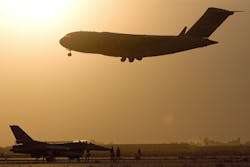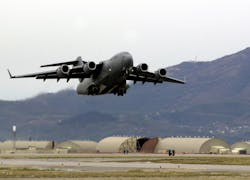When you gotta move a lot of stuff quickly in North America – especially heavy stuff, like vehicles – you need to call in the tractor-trailers.
Be it 100 pallets of machinery parts, food, clothing, or even armored vehicles, a Class 8 tractor pulling a 53-foot dry van, refrigerated, or flatbed trailer is going to offer the most direct way to get it from here to there across the U.S. – through amber waves of grain up over purple mountain majesties.But what if you need the heavy stuff to go farther and faster? Like halfway around the world? And like NOW?
That’s when you call in the tractor-trailer of the sky: the C-17 Globemaster III.
Back in another life, when I covered the air cargo market for a living, I got up close and familiar with the C-17 – or rather, the MD-17 as it was first called, as McDonnell Douglas originally developed this versatile aircraft for the U.S. Air Force back in the late 1980s and early 1990s.
After Boeing acquired McDonnell Douglas back in 1997, the new C-17 designation came into being, but it didn’t alter the plane’s specifications one iota.
[To view more photos of the C-17, click here.]
Measuring 174 ft. long, 55.1 ft. high, with a wingspan of 169 ft., 10 in., the C-17 is powered by four fully reversible Pratt & Whitney PW-100 engines currently used on the Boeing 757.
Each engine is rated at 40,440 pounds of thrust, which allows the C-17 to carry a maximum load of 170,900 pounds some 2,400 nautical miles without refueling, with a top cruising speed of 405 knots at an altitude of 28,000 ft. (though it can go higher, up to 45,000 ft. in altitude.)
Those reversible thrust engines, by the by, help the C-17 take off and land on what are called “austere” runways as short as 3,500 feet and only 90 feet wide.[Picture a big vocational tractor pulling a flatbed over pitted gravel-and-dirt roads, and you get the idea of what landing and take-off conditions the C-17 is expected to deal with.]
What can this bad boy carry? You name it: tanks, heavy-duty Mine-Resistant Ambush Protected (MRAP) vehicles, buses, or 102 full-loaded paratroopers and requisite gear – just about anything you can fit into a cargo compartment that measures 88 ft. long by 18 ft. wide and 12 ft. 4-in. high. [Want more stats? Then just click here.]
With a crew of just three – two pilots and a loadmaster – the C-17 is designed, In military parlance, to provide “rapid strategic delivery” of troops and all types of cargo to main operating bases or directly to forward bases in combat areas if needed.
Not only can the aircraft airdrop paratroops, it can be turned into a flying hospital for medical evacuations when required.
Then again, it better be a multi-use “off-road” type of aircraft, because at $202.3 million a pop (in fiscal 1998 constant dollars), the C-17 sure doesn’t come cheap.
Since its maiden flight on Sept. 15, 1991, a goodly number of C-17s joined the U.S. Air Force and related services for duty. Today, some 187 C-17s are on “active duty,” with 12 attached to the U.S. Air National Guard and 14 attached to the Air Force Reserve.
It’s a pretty impressive aircraft, this “tractor-trailer of the sky.” And it sure provides a whole new perspective for the term “hauling freight,” doesn’t it?
About the Author
Sean Kilcarr
Editor in Chief
Sean Kilcarr is a former longtime FleetOwner senior editor who wrote for the publication from 2000 to 2018. He served as editor-in-chief from 2017 to 2018.


